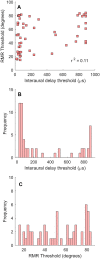Informational Masking in Aging and Brain-lesioned Individuals
- PMID: 36471207
- PMCID: PMC9971540
- DOI: 10.1007/s10162-022-00877-9
Informational Masking in Aging and Brain-lesioned Individuals
Abstract
Auditory stream segregation and informational masking were investigated in brain-lesioned individuals, age-matched controls with no neurological disease, and young college-age students. A psychophysical paradigm known as rhythmic masking release (RMR) was used to examine the ability of participants to identify a change in the rhythmic sequence of 20-ms Gaussian noise bursts presented through headphones and filtered through generalized head-related transfer functions to produce the percept of an externalized auditory image (i.e., a 3D virtual reality sound). The target rhythm was temporally interleaved with a masker sequence comprising similar noise bursts in a manner that resulted in a uniform sequence with no information remaining about the target rhythm when the target and masker were presented from the same location (an impossible task). Spatially separating the target and masker sequences allowed participants to determine if there was a change in the target rhythm midway during its presentation. RMR thresholds were defined as the minimum spatial separation between target and masker sequences that resulted in 70.7% correct-performance level in a single-interval 2-alternative forced-choice adaptive tracking procedure. The main findings were (1) significantly higher RMR thresholds for individuals with brain lesions (especially those with damage to parietal areas) and (2) a left-right spatial asymmetry in performance for lesion (but not control) participants. These findings contribute to a better understanding of spatiotemporal relations in informational masking and the neural bases of auditory scene analysis.
Keywords: Aphasia; Brain lesion; Masking; Parietal; RMR; Stream segregation.
© 2022. The Author(s).
Conflict of interest statement
The authors declare no competing interests.
Figures






Similar articles
-
Informational Masking Effects of Similarity and Uncertainty on Early and Late Stages of Auditory Cortical Processing.Ear Hear. 2021 July/Aug;42(4):1006-1023. doi: 10.1097/AUD.0000000000000997. Ear Hear. 2021. PMID: 33416259
-
Similarity, uncertainty, and masking in the identification of nonspeech auditory patterns.J Acoust Soc Am. 2002 Mar;111(3):1367-76. doi: 10.1121/1.1448342. J Acoust Soc Am. 2002. PMID: 11931314 Clinical Trial.
-
Stream segregation with high spatial acuity.J Acoust Soc Am. 2012 Dec;132(6):3896-911. doi: 10.1121/1.4764879. J Acoust Soc Am. 2012. PMID: 23231120 Free PMC article.
-
Reducing informational masking by sound segregation.J Acoust Soc Am. 1994 Jun;95(6):3475-80. doi: 10.1121/1.410023. J Acoust Soc Am. 1994. PMID: 8046139 Clinical Trial.
-
The effect of spatial separation on informational and energetic masking of speech.J Acoust Soc Am. 2002 Nov;112(5 Pt 1):2086-98. doi: 10.1121/1.1510141. J Acoust Soc Am. 2002. PMID: 12430820
Cited by
-
The effects of aging and hearing impairment on listening in noise.iScience. 2024 Feb 20;27(4):109295. doi: 10.1016/j.isci.2024.109295. eCollection 2024 Apr 19. iScience. 2024. PMID: 38558934 Free PMC article.
References
-
- Bregman AS, editor. Auditory scene analysis: the perceptual organization of sound. Cambridge, MA: MIT Press; 1990.
-
- Yost WA. The cocktail party problem: forty years later. In: Gilkey RH, Anderson TR, editors. Binaural and spatial hearing in real and virtual environments. Lawrence Erlbaum Associates Inc; 1997. pp. 329–347.
-
- Moore BCJ, Gockel H. Factors influencing sequential stream segregation. Acta Acust United Acust. 2002;88:320–332.

